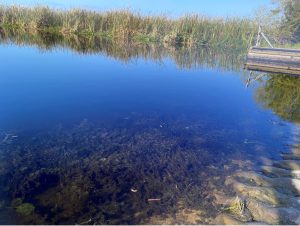
Aquatic Plants and How They Spread
Two things are a given in Florida: hot, humid weather and lots of boat traffic. Have you ever looked over the side of a boat and seen a thick, dark green mat of plant material underwater the water or touching the surface? Chances are, you have. What you saw may have been hydrilla; a noxious aquatic weed that spreads between waterbodies, mainly by way of fragments. When you drove through that thick, topped-out mat of hydrilla, your boat propellor sliced through the hydrilla stems and created hundreds of thousands of fragments.
Congratulations! You have just contributed to the spread of nuisance aquatic plants. No need to fret… unless you are planning on leaving the current waterbody with your boat, not removing those aquatic plant fragments, and putting your boat in at another boat ramp halfway across the state.
What Does the Research Say?
Research has shown that about half of all boats that leave the boat ramp never remove any aquatic plant fragments that they accumulate, which means these fragments could carried on to the next waterbody a boat visits. This is an extremely problematic practice, especially if you are taking your boat out of one waterbody and relaunching at another boat ramp in the same day.

While the plant fragments that are exposed on your boat trailer will dry out as you travel from waterbody to waterbody, or back home, there is a concern about the fragments that are trapped between the boat hull and the bunk. The fragments that are trapped between the boat hull and the bunk may not fully dry out and may still be able to grow into new plant mats when you go to launch your boat next time. Current research has shown that the type of bunk material (bare wood, carpeted, or plastic slips) influences the time it takes to fully dry out the aquatic plant fragments that are crushed on the boat bunks.
How Long Can Aquatic Plant Fragments Survive?
Research has shown that in Florida’s cooler months (January through March) that after 14 days of drying, 100% of all hydrilla fragments remain viable that were crushed and dried on carpet, plastic, or bare wood bunks. In the warmer months (April through June), hydrilla fragments that were dried on carpeted bunks had 0% fragment viability after 14 days of drying as compared to 20% viability for bare wood bunks, and 100% fragment viability for plastic-covered bunks. Viability is the ability of the plant fragments to regrow following a drying period.
So, what does this mean for you? Take the time to clean your boat of any aquatic plant fragments before leaving the boat ramp, empty any live wells or bait pails at the boat ramp, and do not move aquatic organisms from one waterbody to another. Finally, if you chose not to remove any aquatic plant fragments, allow adequate time (at least 14 days in warmer temperatures) for the boat and bunks to adequately dry out and limit viable fragment transfer.
Are you interested in more information on how to prevent the spread of harmful aquatic plants and other species? Visit Stop Aquatic Hitchhikers.
This blog post was written by Taylor Darnell, UF/IFAS CAIP graduate student. This post features research and information from his graduate research project and thesis. Questions or comments can be sent to the UF/IFAS CAIP communications manager at caip@ifas.ufl.edu. Follow UF/IFAS CAIP on Instagram, Facebook, and Twitter. Subscribe for more blogs like this one.
UF/IFAS Center for Aquatic and Invasive Plants. Turning Science Into Solutions.
Did you find this post helpful? Click the heart below!
 5
5
